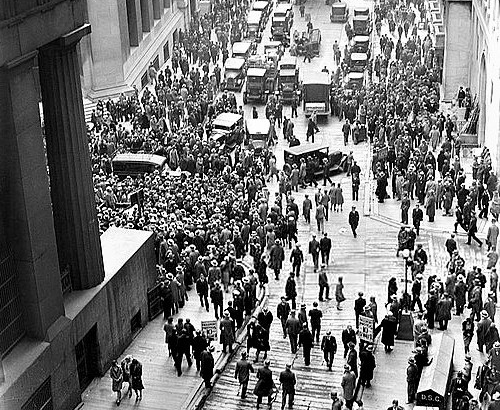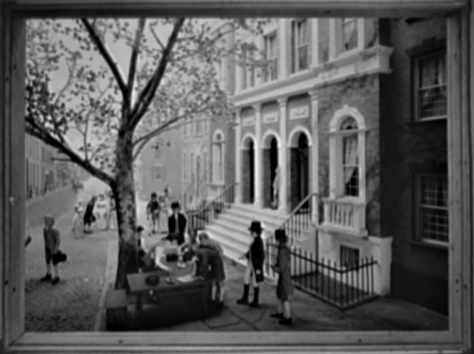Wall Street, because it tries to discern future values, is usually a leading indicator. It began to recover, for instance, from the financial debacle of 2008 in March of the next year. But the economy didn’t begin to grow again until June of 2009.
But sometimes Wall Street separates from the underlying economy and loses touch with economic reality. That is what happened in 1929 and brought about history’s most famous stock market crash.
The 1920’s were a prosperous time for most areas of the American economy and Wall Street reflected that expansion. But rural America was not prospering. In 1900, one-third of all American crop land had been given over to fodder crops to feed the country’s vast herd of horses and mules. But by 1930, horses had largely given way to automobiles and trucks while the mules had been replaced by the tractor.
As more and more agricultural land was turned over to growing crops for human consumption, food prices fell and rural areas began to fall into depression. Rural banks began failing at the rate of about 500 a year.
Because the major news media, then as now, was highly concentrated in the big cities, this economic problem went largely unnoticed. Indeed, while the overall economy rose 59 percent in the 1920s, the Dow Jones Industrial Average increased 400 percent.
The Federal Reserve in the fall of 1928, raised the discount rate from 3.5 percent to 5 percent and began to reduce the increase in the money supply, in hopes of getting the stock market to cool off.
But by then, Wall Street was in a speculative bubble. Fueling that bubble was a very misguided policy by the Fed. It allowed member banks to borrow at the discount window at five percent. The banks in turn, loaned the money to brokerage houses at 12 percent. The brokers then loaned the money to speculators at 20 percent. The Fed tried to use “moral suasion” to get the banks to stop borrowing in this way. But if a bank can make 7 percent on someone else’s money, it is going to do so. The Fed should have just closed the window for those sorts of loans, but didn’t.
By Labor Day, 1929, the American economy was in a recession but Wall Street still had not noticed. On the day after Labor Day, the Dow hit a new all-time high at 381.17. It would not see that number again for 25 years. Two days later the market began to wake up.
A stock market analyst of no great note, Roger Babson, gave a talk that day in Wellesley, Massachusetts, and said that, “I repeat what I said at this time last year and the year before, that sooner or later a crash is coming.” When news of this altogether unremarkable prophecy crossed the broad tape at 2:00 that afternoon, all hell broke loose. Prices plunged (US Steel fell 9 points, AZT&T 6) and volume in the last two hours of trading was a fantastic two million shares.
Remembered as the Babson Break, it was like a slap across the face of an hysteric, and the mood on the Street went almost in an instant from “The sky’s the limit” to “Every man for himself.”
For the next six weeks, the market trended downwards, with some plunges followed by weak recoveries. Then on Thursday, October 23rd, selling swamped the market on the second highest volume on record. The next morning there was a mountain of sell orders in brokerage offices across the country and prices plunged across the board. This set off a wave of margin calls, further depressing prices, while short sellers put even more pressure on prices.
A group of the Street’s most important bankers met at J. P. Morgan and Company, across Broad Street from the exchange.
Together they raised $20 million to support the market and entrusted it to Richard Whitney, the acting president of the NYSE.
At 1:30, Whitney strode onto the floor and asked the price of US Steel. He was told that it had last traded at 205 but that it had fallen several points since, with no takers.
“I bid 205 for 10,000 Steel,” Whitney shouted. He then went to other posts, buying large blocks of blue chips. The market steadied as shorts closed their positions and some stocks even ended up for the day. But the volume had been an utterly unprecedented 13 million shares.
The rally continued on Friday but there was modest profit taking at the Saturday morning session. Then, on Monday, October 28th, selling resumed as rumors floated around that some major speculators had committed suicide and that new bear pools were being formed.
On Tuesday, October 29th, remembered thereafter as Black Tuesday, there was no stopping the collapse in prices. Volume reached 16 million shares, a record that would stand for nearly 40 years, and the tape ran four hours late. The Dow was down a staggering 23 percent on the day and nearly 40 percent below its September high.
Prices trended downwards for more than another month, but by the spring of 1930 the market, badly over sold by December, had recovered about 45 percent of its autumn losses. Many thought the recession was over. But then the federal government and the Federal Reserve began making a series of disastrous policy blunders that would turn an ordinary recession into the Great Depression.
John Steele Gordon was born in New York City in 1944 into a family long associated with the city and its financial community. Both his grandfathers held seats on the New York Stock Exchange. He was educated at Millbrook School and Vanderbilt University, graduating with a B.A. in history in 1966.
After college he worked as a production editor for Harper & Row (now HarperCollins) for six years before leaving to travel, driving a Land-Rover from New York to Tierra del Fuego, a nine-month journey of 39,000 miles. This resulted in his first book, Overlanding. Altogether he has driven through forty-seven countries on five continents.
After returning to New York he served on the staffs of Congressmen Herman Badillo and Robert Garcia. He has been a full-time writer for the last twenty years. His second book, The Scarlet Woman of Wall Street, a history of Wall Street in the 1860’s, was published in 1988. His third book, Hamilton’s Blessing: the Extraordinary Life and Times of Our National Debt, was published in 1997. The Great Game: The Emergence of Wall Street as a World Power, 1653-2000, was published by Scribner, a Simon and Schuster imprint, in November, 1999. A two-hour special based on The Great Game aired on CNBC on April 24th, 2000. His latest book, a collection of his columns from American Heritage magazine, entitled The Business of America, was published in July, 2001, by Walker. His history of the laying of the Atlantic Cable, A Thread Across the Ocean, was published in June, 2002. His next book, to be published by HarperCollins, is a history of the American economy.
He specializes in business and financial history. He has had articles published in, among others, Forbes, Forbes ASAP, Worth, the New York Times and The Wall Street Journal Op-Ed pages, the Washington Post’s Book World and Outlook. He is a contributing editor at American Heritage, where he has written the “Business of America” column since 1989.
In 1991 he traveled to Europe, Africa, North and South America, and Japan with the photographer Bruce Davidson for Schlumberger, Ltd., to create a photo essay called “Schlumberger People,” for the company’s annual report.
In 1992 he was the co-writer, with Timothy C. Forbes and Steve Forbes, of Happily Ever After?, a video produced by Forbes in honor of the seventy-fifth anniversary of the magazine.
He is a frequent commentator on Marketplace, the daily Public Radio business-news program heard on more than two hundred stations throughout the country. He has appeared on numerous other radio and television shows, including New York: A Documentary Film by Ric Burns, Business Center and Squawk Box on CNBC, and The News Hour with Jim Lehrer on PBS. He was a guest in 2001 on a live, two-hour edition of Booknotes with Brian Lamb on C-SPAN.
Mr. Gordon lives in North Salem, New York. His email address is jsg@johnsteelegordon.com.
Click Here to have the NEWEST essay in this study emailed to your inbox every day!
Click Here to view the schedule of topics in our 90-Day Study on American History.


